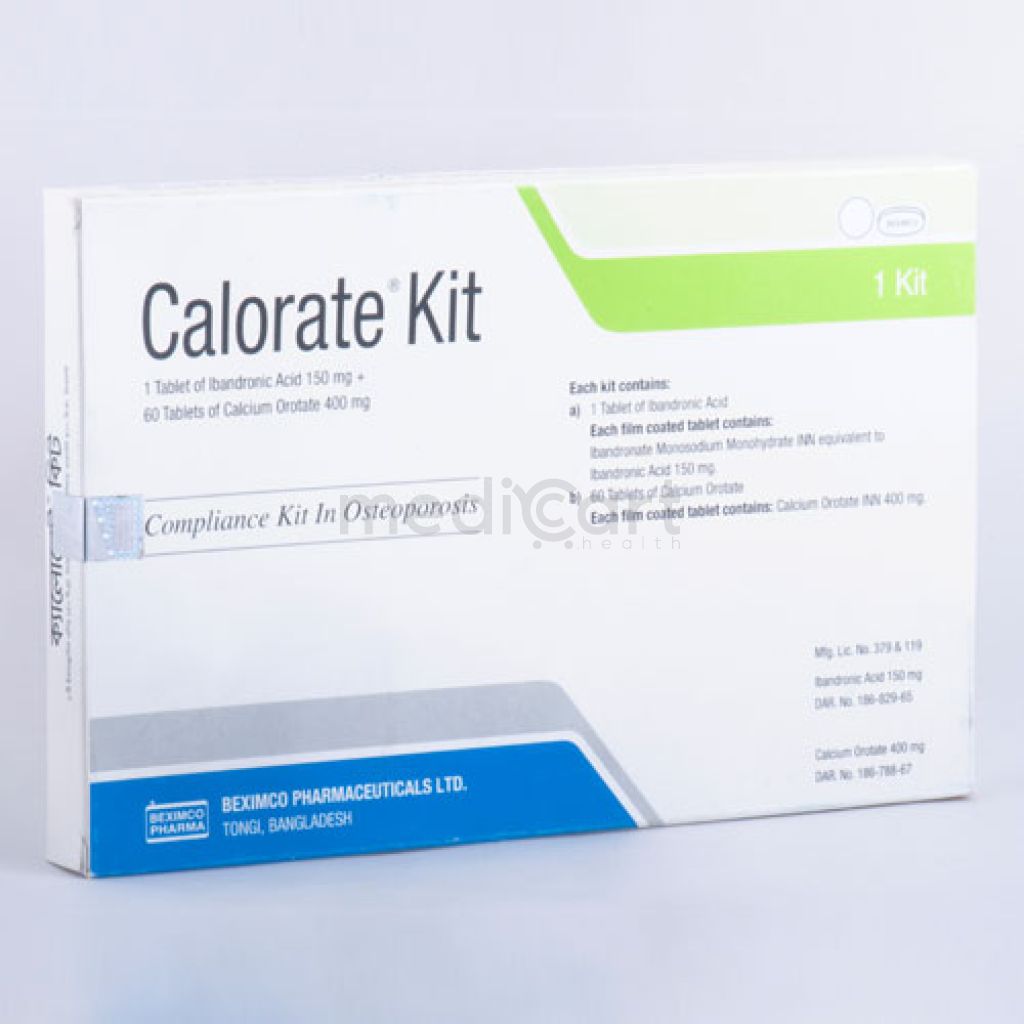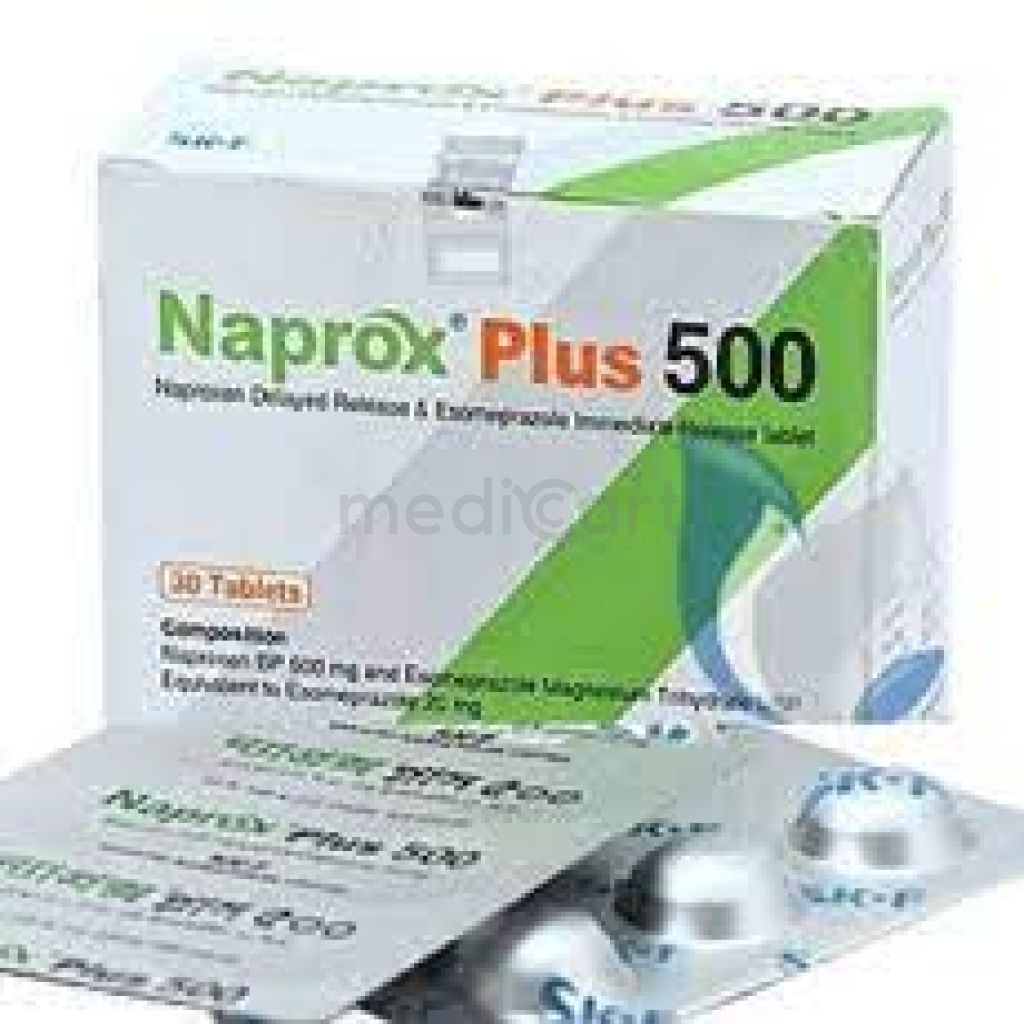

Calorate Kit - 150mg
Tablet
Pack Size :
1 Kit x 1 Box
Generics :
Ibandronic Acid & Calcium Orotate
Manufacturer :
Beximco Pharmaceuticals Ltd.
Best Price *
TK
990.00
* Delivery will be done in Dhaka city only.
Alternative Product
More Information About - Calorate Kit - 150mg
Description
Generic Name
Ibandronic acid+ Calcium OrotatePrecaution
Ibandronic acid: Upper Gastrointestinal Adverse Reactions: Ibandronic acid like other bisphosphonates administered orally may cause local irritation of the upper gastrointestinal mucosa. Because of these possible irritant effects, caution should be used when Ibandronic acid is given to patients with active upper gastrointestinal problems (such as known Barrett?s esophagus, dysphagia, other esophageal diseases, gastritis, duodenitis or ulcers). Hypocalcaemia and Mineral Metabolism: Treat hypocalcemia and other disturbances of bone and mineral metabolism before starting therapy. Musculoskeletal Pain: Severe and occasionally incapacitating bone, joint, and/or muscle pain has been reported in patients taking Ibandronic acid and other bisphosphonates. Jaw Osteonecrosis: Osteonecrosis, primarily in the jaw, has been reported in patients treated with bisphosphonates. Most cases have been in cancer patients undergoing dental procedures, but some have occurred in patients with postmenopausal osteoporosis or other diagnoses. Calcium orotate: Precaution is needed if the patient is allergic to calcium orotate. Before using this product in kidney disease, kidney stones, little or no stomach acid (achlorhydria), disease of the pancreas, a certain lung disease (sarcoidosis), difficulty absorbing nutrition from food (malabsorption syndrome) precaution is needed.Indication
Treatment & Prevention of Osteoporosis in women after menopauseContra Indication
Ibandronic acid: Abnormalities of the esophagus, which delay esophageal emptying Inability to stand or sit upright for at least 60 minutes Hypocalcaemia Known hypersensitivity to Ibandronic acid or to any of its excipients Calcium orotate: Kidney stone Kidney disease Sarcoidosis Increased activity of the parathyroid gland High amount of calcium in urine High amount of calcium in the blood Extreme loss of body waterDose
N/ASide Effect
Ibandronic acid: Flu-like symptoms (e.g. myalgia, arthralgia, fever, chills, fatigue, nausea, loss of appetite, bone pain), atypical fractures, osteonecrosis of the jaw, ocular inflammation, acute renal failure, hypocalcaemia, musculoskeletal pain. Rarely, anaemia, bronchospasm, taste disturbance, paraesthesia, uraemia; transient fever (IV); abdominal pain, dyspepsia, severe oesophageal reactions (oral).) Potentially Fatal: Anaphylactic reaction/shock. Calcium orotate: Bloating and swelling in the abdomen are common side effects of Calcium Orotate. Constipation, nausea, vomiting, headache, increased thirst/urination, may occur infrequently.Pregnancy Category
Name : C
Description
Animal reproduction studies have shown an adverse effect on the fetus and there are no adequate and well-controlled studies in humans, but potential benefits may warrant use of the drug in pregnant women despite potential risksMode of Action
Ibandronic Acid (Ibandronate Sodium Monohydrate) is a nitrogen-containing bisphosphonate that inhibits osteoclast-mediated bone resorption. The action of Ibandronate on bone tissue is based on its affinity for hydroxyapatite, which is part of the mineral matrix of bone. Ibandronate inhibits osteoclast activity and reduces bone resorption and turnover. In postmenopausal women, it reduces the elevated rate of bone turnover, leading to, on average, a net gain in bone mass. Calcium Orotate, a calcium supplement with a functional amino acid chelating ligand - orotic acid. Orotic acid assists the transport of calcium through cellular membrane structures, facilitating the intracellular uptake of calcium, particularly in bone. Calcium Orotate also helps in the maintenance of healthy cartilage. Furthermore, Orotate is involved in the synthesis of DNA (deoxyribonucleic acid) and RNA (ribonucleic acid). Calcium Orotate has the ability to penetrate complex cell membranes and it can be metabolized in cartilage.Interaction
Ibandronic Acid: Products containing calcium and other multivalent cations (such as Aluminum, Magnesium, Iron etc.), including milk, food, and antacids are likely to interfere with absorption of ibandronate. It is also found to interact with H2 blockers such as Ranitidine in several clinical trials. Calcium can decrease absorption of the following drugs when taken together- biphosphonates (e.g. alendronates), quinolone antibiotics (e.g. ciprofloxacin, levofloxacin) and tetracycline antibiotics (e.g. doxycycline, minocycline), levothyroxine, phenytoin (anticonvulsant), and tiludronate disodium (to treat Paget's disease). Thiazide-type diuretics can interact with calcium supplements, increasing the risks of hypercalcemia and hypercalciuria.Pregnancy Category Note
N/AAdult Dose
1 tablet of ibandronic acid 150 mg once monthly on the same date of each month is recommended. To maximize clinical benefit of ibandronic acid 2 tablets of Calcium Orotate 400mg per day usually recommended in divided dosage.Child Dose
N/ARenal Dose
N/AAdministration
To maximize absorption and clinical benefit, Ibandronic acid should be taken at least 60 minutes before the first food or drink (other than water) of the day or before taking any oral medication or supplementation, including calcium, antacids, or vitamins. Ibandronic acid tablets should be swallowed whole with a full glass of plain water (6 to 8 oz) while the patient is standing or sitting in an upright position. Patients should not lie down for 60 minutes after taking Ibandronic acid. Patients should not eat, drink anything except water, or take other medications for at least 60 minutes after taking Ibandronic acid. Patients should not chew or suck the tablet because of a potential for oropharyngeal ulceration.Disclaimer
The information provided herein are for informational purposes only and not intended to be a substitute for professional medical advice, diagnosis, or treatment. Please note that this information should not be treated as a replacement for physical medical consultation or advice. Great effort has been placed to provide accurate and comprehensive data. However, Medicart along with its authors and editors make no representations or warranties and specifically disclaim all liability for any medical information provided on the site. The absence of any information and/or warning to any drug shall not be considered and assumed as an implied assurance of the Company.





